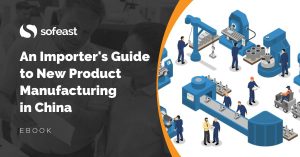 Maybe you are looking for a new Chinese factory and you are not sure how to find a good one. You’d like to get inspiration from those companies that have THE BEST supplier screening process.
Maybe you are looking for a new Chinese factory and you are not sure how to find a good one. You’d like to get inspiration from those companies that have THE BEST supplier screening process.
Well, look no further than the car industry. A car assembler, say General Motors or Volkswagen, has to decide on 1 supplier for each part of a new car — and then they CANNOT change that supplier for the life of the car in question.
Why can’t car manufacturers switch suppliers?
David Collins, consulting director at from CMC, explained to me why. Double-sourcing one part — let’s say buying a seat from two suppliers — would require so much additional work and testing that the final bill would approximate 500 million USD. Very heavy testing is required by law, and 1 new part in a car would make the whole testing process start again.
So having a backup supplier is impossible. That’s a very uncomfortable situation. When a manufacturer has quality or delivery issues, the implications for their customer (the car plant) are enormous. A downtime in a car factory costs tens of thousands of dollars per minute.
In this situation, qualifying the suppliers and approving their parts is a critical process. Picking a wrong supplier (which will deliver late, or deliver poor quality) is extremely costly.
How do car manufacturers select the right suppliers?
Car manufacturers use the PPAP (Production Part Approval Process) to quality each part coming from outside suppliers. The PPAP includes quality tools that are usually seen as particular to the auto industry, but that are applicable in any industry — electronics, furniture, etc.
Now, let’s be realistic. The PPAP process is very heavy and involves a LOT of documentation. It is very useful in bringing the risk of working with the wrong supplier down, but should you go through all these steps? No.
What you should do is the 20% of the work that will get you 80% of the results.
Here are the PPAP process steps:
- Design Records
- Authorized Engineering Change Documents
- Customer Engineering Approval, if required
- Design Failure Modes and Effects Analysis (DFMEA) applied in special situations
- Process Flow Diagram
- Process Failure Modes and Effects Analysis (PFMEA)
- Control Plan
- Measurement Systems Analysis (MSA)
- Dimensional Results
- Records of Material / Performance Test Results
- Initial Process Studies
- Qualified Laboratory Documentation
- Appearance Approval Report (AAR)
- Sample Production Parts
- Master Sample
- Checking Aids
- Customer-Specific Requirements
- Part Submission Warrant (PSW)
How can importers get inspiration from the PPAP?
Among the above list, here are the tools every importer should try to apply when selecting a new supplier for custom-made products:
- Design Records
- Authorized Engineering Change Documents
- Design Failure Modes and Effects Analysis (DFMEA) if the design is a bit complicated
- Process Flow Diagram
- Process Failure Modes and Effects Analysis (PFMEA)
And, once an order has been issued and the factory is willing to invest time and energy in improving their processes and their organization, these steps generally make sense:
- Control Plan
- Measurement Systems Analysis (MSA)
- Dimensional Results
- Initial Process Studies (including running small pilot batches at the rate of mass production)
- Master Sample
- Checking Aids
What do you think?
Are you designing, or developing a new product that will be manufactured in China?
Sofeast has created An Importer’s Guide to New Product Manufacturing in China for entrepreneurs, hardware startups, and SMEs which gives you advance warning about the 3 most common pitfalls that can catch you out, and the best practices that the ‘large companies’ follow that YOU can adopt for a successful project.
It includes:
- The 3 deadly mistakes that will hurt your ability to manufacture a new product in China effectively
- Assessing if you’re China-ready
- How to define an informed strategy and a realistic plan
- How to structure your supply chain on a solid foundation
- How to set the right expectations from the start
- How to get the design and engineering right
Just hit the button below to get your copy (please note, this will direct you to my company Sofeast.com):


Hi Renaud,
Great article, very informative.
Paul
Renaud’s suggestions are on target. In automotive we have a highly refined but paper intense process. The critical pieces will get you 80%+ of the benefit.
A few comments from my experience implementing these in China… what to do and what to watch for.
1. To me the control plan is crucial. What characteristics will be checked in process (or after processing? How often? With what controls? …. A discipline that many Chinese factories have trouble buying into: suppose we check 5 pieces each hour. If any are nonconforming then the last hour’s production needs to be sorted 100%. Typical Chinese thought is that we only toss the pieces that were found bad.
I do regular process audits following the process control plan. This proves that the program matters. It also gives you a way to detect changes made by the supplier without authorization.
2. The idea of PPAP is to validate the volume production process. If you read the book it says that you should run 300 pieces in the standard production process and sample a few at random, Then check every single drawing dimension on each of those few (typically 3 – 6 pieces.)
Chinese factories will see your request for 3 – 6 pieces and run 3 – 6 pieces… or, perhaps, run 25 pieces and sort them until they get the best 3 – 6; they will measure and report on these best parts and scrap the others. Then once you accept the PPAP you will get the normal process results. (Perhaps adding the 19 parts that were set aside from the pilot batch!)
In automotive we view the short run as a prototype or pilot. If the factory wants to do this and have you confirm the parts, fine! But, you still need to do a true PPAP – run the 300 parts from the first production order, select 3 to 6 at random, and then check everything in detail. The factory will resist this, but it will give you a *true* reading of their actual manufacturing process. You may need to be present, or have an independent inspector present, to do this. But it will be worth it.
3. PFMEA – Process Failure Mode Effects Analysis. If you run safety related products as I do you can’t ignore this technique… but, it is *really* hard to do correctly at the outset. Instead of expecting it at the outset, have your supplier do an initial PFMEA; don’t worry about how poorly it was done… then, if and when you find defects, ask how they happened, and insist that the PFMEA be updated to reflect that failure. Over time, the PFMEA will grow as a living document and have some true value.
Hope that these will help as well!
Brad Pritts
Eagle and Dragon LLC
Great comment, thanks Brad!
– Control Plan — yes that’s an excellent document.
– Pilot Runs — yes Chinese factories hate that. if they dedicate a production line for your products it gets easier.
– PFMEA — so you are suggesting to use it for corrective actions more than preventive actions. Makes a lot of sense!